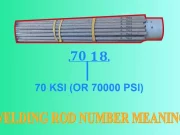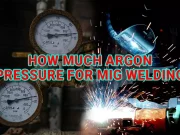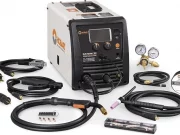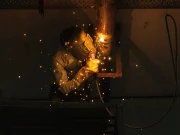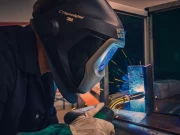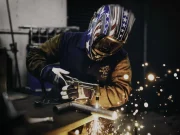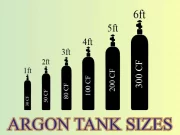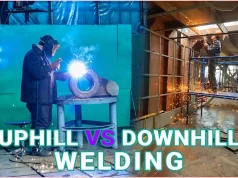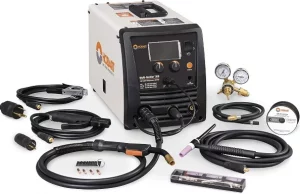Any job that you undertake carries some element of risk. These are some professions and careers that we deem to be more dangerous, while some pose very few mortal risks.
Several things have to be considered while determining how dangerous a profession is. Some jobs require that you actively put your life on the line. Examples include military jobs, the bomb squad, special police, etc.
On a safety spectrum, the topic of welding is quite controversial. While many measures ensure the safety of welders, there are still grave concerns regarding the overall risks welders face.
You must understand how to weld safely for the sake of your health and that of the people around you.
Does welding shorten your life?
Welding can shorten your life if you do not observe the safety requirements. There are various risks that welders are exposed to, including electrocution, inhaling carcinogenic fumes, heat exposure, among others. You can mitigate all these risks through basic safety and common sense.
Nature And Types Of Risks Involved In Welding
Welding has many risks involved. Some of the risks appear obvious, but some are pretty obscure. These risks are:
Electrocution
Welding involves using high amounts of electric current to melt joining rods onto metallic surfaces. Any operation involving the use of electricity carries the risk of electrocution.
Electrocution risk is higher when welding in the rain or on pools of water. When your skin makes contact with the weld tip, you will be electrocuted. Since the current size involved is large, these electrocutions are fatal.
Faulty welding appliances also put you at risk of electrocution.
Prolonged heat exposure
Welding involves great heat transfer. The electrical current generates a lot of heat when melting metallic components. The heat generated can be dangerous.
A welding flame is approximately 6000°F. It is more than enough to induce serious scalding and burns.
Welding continuously for prolonged periods will induce heat-related medical conditions. These conditions include hyperthermia, severe dehydration, and in extreme cases, heatstroke. Welding is even more dangerous when done in poorly ventilated areas.
Noise-Induced Hearing Loss exposure
Noise-Induced Hearing Loss (NHIL) is a condition that affects many welders after several years on the job.
Metal Inert Gas welding causes 85 to 102 decibels of noise. Miller stick welding induces an average of 85 decibels, while carbon arc welding induces 110 decibels of noise.
It, therefore, doesn’t come as a surprise that these noise levels can cause serious hearing damage. Hearing damage will not manifest until years into the job when it is irreversible.
Fire hazards
There are several fire hazards in welding. The most prominent cause of fire in welding stations is poor tank safety.
Welding uses very volatile and combustible gases. The most combustible welding gas is acetylene, which burns at 3100°C.
These types of temperatures are fatal. They will result in death or serious permanent injuries and property damage.
Fire occurs due to leaking gas tanks. These tanks could be faulty or damaged due to poor handling or improper storage.
Exposure to Poisonous Fumes
Welding involves high energy changes. These energy changes occur due to heat involving metals and ignitable gases.
As a result of the interaction of the gases and metal, toxic gaseous elements get released as byproducts.
An example of a toxic gas released as a result of welding is Chromium (VI). The gas has adverse effects, including dizziness, throat irritation, nausea as short-term effects.
Long-term effects of exposure cause more severe effects such as larynx cancer, stomach ulcers, kidney nephron clogs, lung cancer, and urinary tract cancer.
Impact injuries
When welding, you are exposed to many impact injuries, depending on the type of workshop. Some workshops are left in a state of neglect. Failure to observe OSHA safety standards can cause serious work-related injuries.
It is important to maintain a safe welding workstation to avoid impact injuries.
What Welding Safety Equipment Do I Need?
Before you embark on any welding project, there are some safety apparels that you must have. The equipment will shield you from the risks that we have discussed. They include:
Welding Face Helmet
When welding, you must ensure that you protect your face. Welding could cause serious facial damage.
Proper welding helmets will shield you from flaming hot metallic projectile, thermal radiation, and other debris.
A proper welding helmet must have eye protection. Welding produces blinding sparks that can cause blindness after repeated exposure. Helmets afford proper ultra-violet protection, protecting our optical nerves from damage.
Click here to see the best welding helmets for TIG.
Non-conductive safety gloves
It would be best never to overlook the importance of proper safety gloves. These items can be the difference between safety and serious medical bills.
Safety gloves protect your hands, especially when working with non-viscous slug rods. The slugs could spill, and if your hands are exposed, it will cause serious scalding. When choosing a pair of safety gloves, ensure that they are completely insulated from heat.
These gloves should also not conduct electric current. Click here for the best welding gloves.
Earplugs
When welding, our ears are exposed to anywhere between 80 to 110 decibels of noise. These types of noise can have serious hearing-related implications, as we have already discussed.
The solution is to use a pair of high-quality earplugs. These earplugs should cover your ears completely.
Aside from shielding your ears from welding noise, earplugs also prevent sparks from inadvertently entering your ears. Hot sparks in your ears could cause permanent hearing loss.
Protective heat jacket
One of the biggest concerns with welding is heat exposure. We have seen the adverse effect of prolonged heat exposure. The best way to combat welding heat is by using a high-quality protective heat jacket.
Aside from shielding you from excess heat, these jackets keep you safe from welding debris.
They are covered in several layers of insulative material that can withstand spark projectile. These jackets should be sturdy enough to shield you from welding slug.
Workshop respirators
Welding generates a lot of heat. Welding flames also consume a considerable amount of oxygen, and it could put you at risk of suffocation.
You must always ensure that you are welding in an area with proper circulation. You can now ensure that your workshop is ventilated, thanks to respirators.
Respirators also waft out carcinogenic gases from the workshop. Welders are less likely to develop lung-related illnesses thanks to workshop respirators.
Proper Welding Tank Safety
Welding tank mismanagement is one of the leading causes of injuries in welding. These tanks are useful for welding, but if they are used improperly, they can cause major harm. Here are some precautions:
Proper storage
Welding tanks must be stored properly. Make sure your tanks are stored vertically. Other gases do not separate from acetone when tanks are stored vertically.
It would be beneficial if tanks were kept out of direct sunshine, as this might cause the gas within to heat up and expand past the tank’s critical capacity.
Close the valves
Ensure you keep the valves closed to prevent the welding gases from leaking. Any good welding tank must have proper valves to ensure that the gases do not escape.
Leaking gases are not only hazardous to your health; they could cost you thousands of dollars each year.
Avoid smoking near welding tanks.
Smoking near gas tanks is one of the most dangerous things you can do. Smoking in the vicinity of welding gas tanks is hazardous and might result in significant repercussions.
Welding gases, especially acetylene, are volatile. Smoking near these gas tanks could result in explosions.
Even non-combustive welding gases pose a risk to smokers. These tanks could explode, causing permanent injuries, death, and property damage.
Chose aluminum tanks
What makes aluminum tanks superior to steel tanks? Unlike steel tanks, which may rust under certain situations, aluminum tanks are less prone to rust.
As a result, aluminum has a higher expansion threshold and is less prone to pressure cracking. Tanks made of aluminum are also lighter than steel tanks. It will take less effort to move them around.
Pre-purchase inspection
You should carefully inspect your welding tank before purchasing it. Tanks with dents are not structurally sound and should not be purchased.
Corrosion should be avoided, especially at the gauge connection points. Corrosion might cause holes in the tank.
Finally, check for fractures in the tank. Cracks that develop superficially may spread quickly.
Conclusion
Welding, much like many other professions, has some risks involved. There are several measures that welders should take to stay safe and healthy. These measures involve using the correct equipment and attire and overall common sense.
Some of the risks in welding include lung disease, impact injuries, several types of cancer, prolonged heat exposure, and electrocution. Research in the Journal of Public health states that welders are 37% likely to develop cancer due to exposure to carcinogenic fumes.
It would help if you always observed proper safety regulations when welding.
You May Like These Articles As Well:




